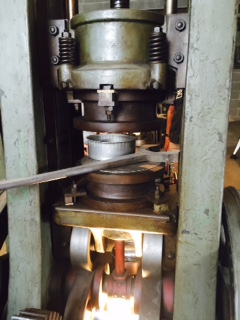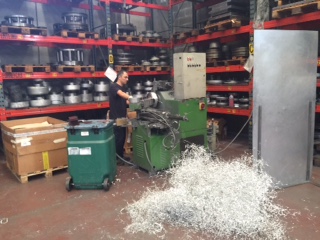Confession: I’m a housewares junkie. I can’t resist anything that belongs in the kitchen or on the table. My shelves and cupboards are full, so in order to acquire I’ve got to eliminate. Since some of my ceramic-coated pans were getting weary I was thrilled by an offer from my friend Maurizio di Dio to visit the Pentole Agnelli factory outside Bergamo. He gave me their Manuale Strumenti di Cotture (a guide to professional cookware, available on their US website) which I carefully studied. It’s thorough, all about how pots and pans are made, with sections on hygiene, metal conductivity, cooking materials with pros and cons explained, induction cookware, cooking instrument shapes—the correct shape and material for each kind of cooking. I took a long hard look at my equipment with a far more critical eye before heading north.
The company was founded in Bergamo in 1907 by Baldassare Agnelli, utilizing a new wave material – aluminum -- forged to make a wide range of products, including pots and pans, farm and industrial equipment, mess kits. They grew from artisanal to industrial production, moved out of the city, and Agnelli heirs joined the company.
I met Maurizio in the parking lot, he introduced me to Baldassare Agnelli (they recycle names as well as aluminum) and we proceeded to the Pot Museum and History of Cooking Instruments. I was fascinated by the turn of the century machinery reproducing parts of the original workshop and the attractively displayed collection of camping sets, kitchen tools, canteens, ladles, strainers, lids, Neapolitan-style coffee pots and much more. Then on to the production, with modern machinery and molds. I learned that nothing is wasted, all aluminum trimscrap recycled. I toured the high-tech Cooking Lab, for research and development as well as offering courses for and by chefs.
We concluded our visit with the shop—armed with my new knowledge about cooking equipment but bearing in mind my limited space. I purchased two sizes of non-stick pans and an enameled cast-iron pot for slow cooking.
I’ve been using them for a few months. I tossed two old, somewhat scratched pans of equal size. Hey, Baldassare and Maurizio, I’m in love. The shapes are perfect, the non-stick is better than any I’ve ever had and now that the weather is cooler I’m braising more, and enjoying my heavy cast-iron pot. And thinking about what I can eliminate in my kitchen to make room for more purchases.
Share this article


